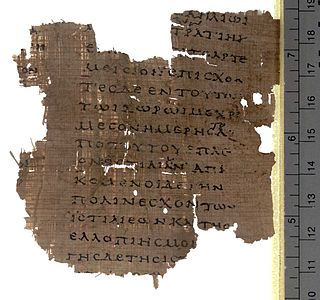
Sculpture is the branch of the visual arts that operates in three dimensions. It is one of the plastic arts. Durable sculptural processes originally used carving and modelling, in stone, metal, ceramics, wood and other materials but, since Modernism, there has been an almost complete freedom of materials and process. A wide variety of materials may be worked by removal such as carving, assembled by welding or modelling, or molded or cast.

Khufu, known to the Greeks as Cheops, was an ancient Egyptian monarch who was the second pharaoh of the Fourth Dynasty, in the first half of the Old Kingdom period. Khufu succeeded his father Sneferu as king. He is generally accepted as having commissioned the Great Pyramid of Giza, one of the Seven Wonders of the Ancient World, but many other aspects of his reign are poorly documented.

Menkaure, was an ancient Egyptian king (pharaoh) of the 4th dynasty during the Old Kingdom, who is well known under his Hellenized names Mykerinos and Menkheres. According to Manetho, he was the throne successor of king Bikheris, but according to archaeological evidences he rather was the successor of king Khafre. Menkaure became famous for his tomb, the Pyramid of Menkaure, at Giza and his beautiful statue triads, showing the king together with his wives Rekhetre and Khamerernebty.

The history of ancient Egypt spans the period from the early prehistoric settlements of the northern Nile valley to the Roman conquest, in 30 BC. The Pharaonic Period is dated from the 32nd century BC, when Upper and Lower Egypt were unified, until the country fell under Macedonian rule, in 332 BC.

The Histories of Herodotus is considered the founding work of history in Western literature. Written in 440 BC in the Ionic dialect of classical Greek, The Histories serves as a record of the ancient traditions, politics, geography, and clashes of various cultures that were known in Western Asia, Northern Africa and Greece at that time. Although not a fully impartial record, it remains one of the West's most important sources regarding these affairs. Moreover, it established the genre and study of history in the Western world.

The Museum of Fine Arts in Boston, Massachusetts, is the fifth largest museum in the United States. It contains more than 450,000 works of art, making it one of the most comprehensive collections in the Americas. With more than one million visitors a year, it is the 60th most-visited art museum in the world as of 2017.

Senedj was an early Egyptian king (pharaoh), who may have ruled during the 2nd dynasty. His historical standing remains uncertain. His name is included in the kinglists of the ramesside era, although it is written in different ways: While the kinglist of Abydos imitates the archaic form, the Royal Canon of Turin and the kinglist of Sakkara form the name with the hieroglyphic sign of a plucked goose.

George Andrew Reisner was an American archaeologist of Ancient Egypt, Nubia and Palestine.

Spanning over two thousand years in total, what is called ancient Egypt was not one stable civilization, but instead a civilization in constant change and upheaval commonly split into periods by historians. Likewise, ancient Egyptian architecture is not one style, but a set of styles with commonalities used during each period of ancient Egyptian history.

Aprostocetus is a genus of hymenopteran insects of the family Eulophidae. This very large group has a global distribution.

Vaccinieae is a tribe of over 1000 species in the plant Family Ericaceae. The tribe consists of morphologically diverse woody plants. Species within Vaccinieae can be found on all continents except Australia and Antarctica. Genetic analysis indicates that Vaccinieae is a monophyletic group.
Urgleptes dorcadioides is a species of beetle in the family Cerambycidae. It was described by White in 1855.
Crossotini is a tribe of longhorn beetles of the Lamiinae subfamily. It was described by Thomson in 1864.
Mycerinus is a genus of longhorn beetles of the subfamily Lamiinae.
Mycerinus brevis is a species of beetle in the family Cerambycidae. It was described by Per Olof Christopher Aurivillius in 1914.
Mycerinus limbatus is a species of beetle in the family Cerambycidae. It was described by Kolbe in 1894.
Mycerinus multilineatus is a species of beetle in the family Cerambycidae. It was described by Stephan von Breuning in 1936.
Mycerinus punctiventris is a species of beetle in the family Cerambycidae. It was described by Kolbe in 1893.
Mycerinus subcostatus is a species of beetle in the family Cerambycidae. It was described by Kolbe in 1894.











